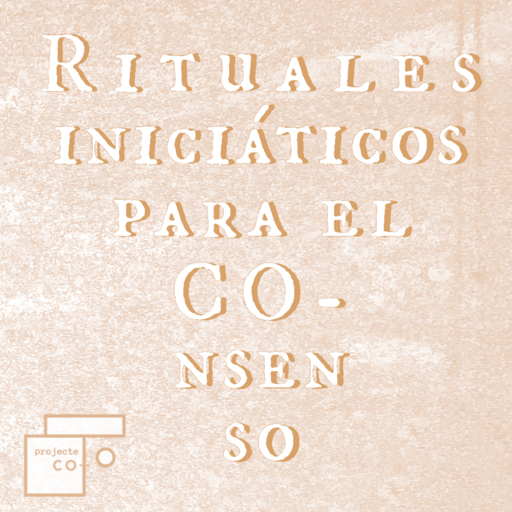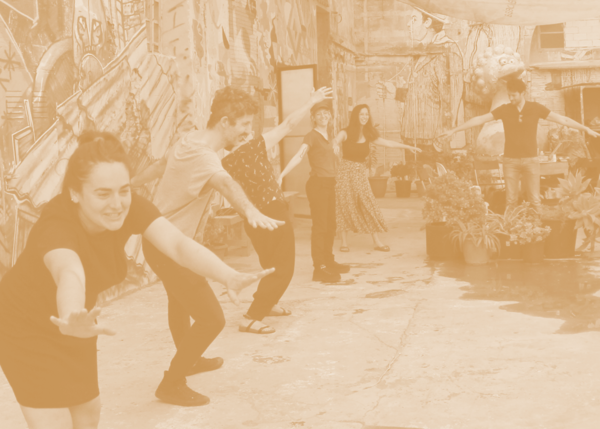
Initiatory rituals for consensus
The consensus of senses is indispensable to (re)establish mediation among bodies. For this reason it is necessary to apply a series of methodologies, or rituals, to make a space adequate for (re)encounters - be it for artists, visitors, participants of activities, institutions and art centers, etc. A place where projecting, stretching, and connecting bodies through the senses can take place. This generates active modes of listening which allow us to safeguard the interaction distances between bodies, considering safety and protection requirements.
A consensus is always an "agreement"; a consensus (con-sense = with sense) is equal to saying "along with all senses". Thus, we propose a series of rituals for a "consensus of all senses". It means to "work with all senses" and also "to work with everyone's senses", with respect to how and how far each person is willing to participate.
Rituals are a community's mode of communication and interconnection. They provide a sense of location and belonging. The bodies become theatrical spaces and their collective movements allow them to physically feel the group. Therefore, ritualized objects acquire a symbolism of great potential for the generation and communication of emotions, safety, and narratives other than covid. To approach safety measures as rituals allows us to incorporate the methodologies for consensus in the form of shared fiction. They adjust naturally to the context, to the concept and/or aesthetic of the artistic event, while distracting from their covid prevention function. Shared fiction gives power to the role of art as a site for the creation and experimentation of alternative fictions, speculated realities, and tentacular narratives, far from the belligerent socio-political and fear-mongering narratives around covid.
This pack of rituals focuses on the first steps, from the preparation of the space to the encounter of individual bodies and their opening towards the group and surroundings. They are preparatory exercises, prior to the start of the activity, which become even more important in such a context. They intend to prepare bodies that have been submitted to strong isolation measures to again be able to communicate emotions, to be receptive, and to participate in a safe context.
Since there are numerous possible rituals, in this document we chose to draft the types of rituals to be considered in each step towards consensus, and point out recommendations for their development. On the other hand, CO-rpus has a repository of detailed rituals (referenced, imagined, experimented) which is available and expandable within CO-laboratorio.
Step 0: The embodiment of space
The step 0 of every initiatory ritual for consensus involves understanding space as an extension of its inhabiting bodies (and vice versa, of bodies as extensions of space since it influences the encounters). It is necessary to recover space as a safe and comfortable place. Instead of provoking fear and constructing barriers and limits for the bodies, the space becomes part of them and generates an organic and fluid continuum for habitability and movement. Therefore, we propose a series of measures or suggestions for this step in order to prepare the space for its embodiment and incarnation.
Step 1: The encounter of individual bodies
Step 1 is the starting point of the encounter of bodies. Being so, the way such an encounter takes place is important, especially in the current situation in which bodies are submitted to isolation measures previously unimaginable. Thus, rituals of welcoming become even more relevant in this encounter. At the same time, they must be re-learnt and re-negotiated. In this step, individual bodies are prepared to come closer to touching.
Step 2: Stretching towards the social body
Step 2 is about stretching towards other bodies. Once situated and encountered, the bodies need to come closer to touching. They need to extend, to dissolve, to tie bonds that connect them to each other and with their surroundings. This exploratory path proposes to activate bodies beyond their preset physical boundaries and mental frames. So we can come closer, through and beyond distances and limitations of the world in which we develop ourselves with our subconsciousness.
The interaction distance between the bodies is an aspect that conditions interpersonal communication: there is a need for physical contact with the other and also the need to keep the required safety distance, while also providing some assimilation and comfort. If keeping distances keeps us apart, we propose to stretch our senses and bodily projections towards other bodies.

